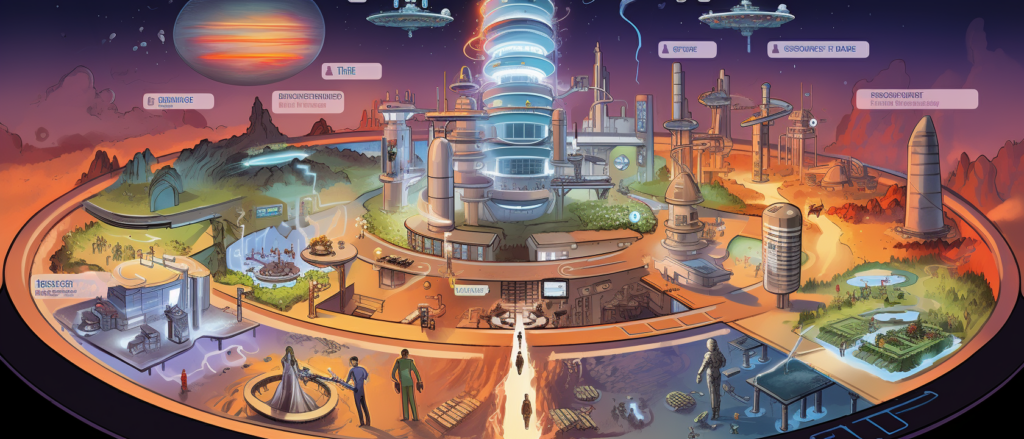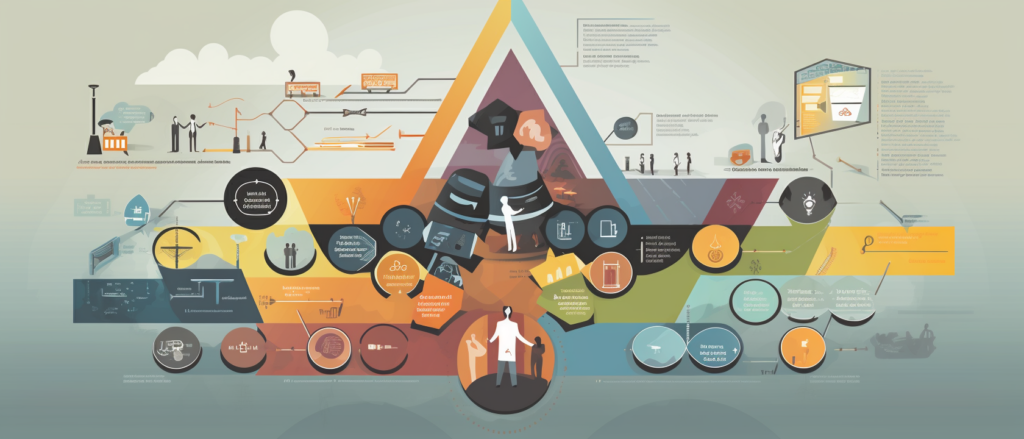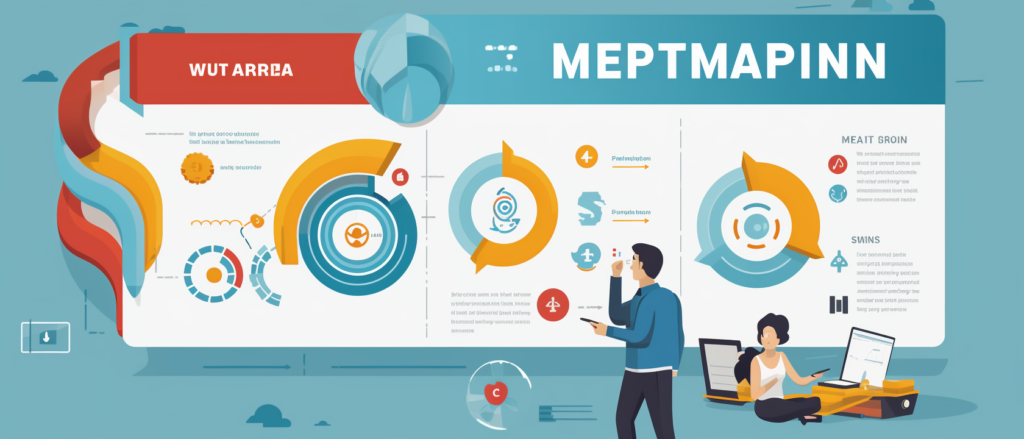Key Takeaways
✅ Situation Analysis: A map is essential for any journey, and in marketing, Situation Analysis is that map. Through a mix of looking inward at strengths and weaknesses, outward at opportunities and threats (that SWOT thing everyone talks about), and sideways at the competition, businesses find their footing. It’s more than just homework; it’s setting up a chessboard for your brand’s success.
✅ Marketing Objectives: Ever tried to hit a target with your eyes closed? That’s marketing without clear Marketing Objectives. Setting those SMART goals (you know, the kind that are clear cut and you can actually tell if you’ve hit them) is like turning on the headlights. They’re the stepping-stones across the river of challenges that lie ahead.
✅ Marketing Strategies: Ever wonder why some brands just seem to get it right? It’s all down to Marketing Strategies. Tackling the big seven – product, price, promotion, place, people, process, and physical evidence – is like having the right tools to build a house. They’re the secret sauce that, when mixed well, make customers come back for seconds.

Introduction
Have you ever wondered how some businesses seem to effortlessly climb to the top? It’s not magic, it’s meticulous planning. Behind every viral campaign and bustling storefront is a Marketing Plan that’s more than just a document; it’s the lifeblood pumping through a business’s efforts to win customers and crush goals. Working with the seven critical components of a marketing strategy is like aligning stars—do it right, and success just seems to fall into place.
This article isn’t just about listing the pieces of the puzzle, though. It’s about taking those seven elements and turning them into a masterpiece that spells out ‘growth,’ ‘engagement,’ and ‘profit.’ By the time we’re done here, you’ll have more than just knowledge; you’ll have a roadmap crafted from tested methods and fresh perspectives that can transform numbers on a screen into real-world triumph. So, if you’re ready for insights that will take your brand places, buckle up. We’re about to dive deep into the heart of effective marketing strategies.
Top Statistics
| Statistic | Insight |
|---|---|
| Customer Experience: 86% of buyers are willing to pay more for a great customer experience. (Source: Forbes) | This surprising statistic shows just how crucial understanding your product and the people who use it really is. A better customer experience often means that your customers will stick around, and might even spend more. Isn’t that a sweet deal? |
| Dynamic Pricing: Can increase profits by up to 25% if done right. (Source: McKinsey & Company) | Now, this is interesting. Price flexibility isn’t just a trendy term; it’s a strategy that could seriously fatten up those profit margins. But remember, it’s like a recipe – one wrong move and it all goes sour. |
| Social Media Impact: 54% of internet users research products on social networks. (Source: Hootsuite) | Social media isn’t just for cat videos and selfies anymore, my friend. It’s a goldmine for promoting your products, because let’s face it, that’s where the crowd’s at. Are you tapping into this powerhouse promoter? |
| E-commerce Growth: Global retail eCommerce sales hit $4.28 trillion in 2020. (Source: eMarketer) | The ‘place’ where you sell matters – and oh boy, these figures shout it loud and clear. The internet’s your oyster, and eCommerce is the pearl. Are you in the right “place” to catch this wave? |
| Employee Experience: Considered important by 80% of business leaders. (Source: Deloitte) | Here’s food for thought: those folks you see around the office or those pixels on a Zoom call? They’re not just part of your team; they’re key players in the way customers perceive your business. Keep them happy, keep them engaged, and it might just reflect in your customer satisfaction. |
Understanding Your Treasure Hunters: Target Market Analysis
Ever thrown a party and worried if people would actually show up? That’s a bit like launching a product without understanding your audience. You need to figure out who’s likely to be excited about what you’re offering—your target market. How do you find these eager attendees? Start by painting a picture of the ideal guest. What do they like? Where do they hang out? Age, gender, hobbies, and buying habits are a few good scribbles for this sketch. This isn’t creepy stalking; it’s about knowing your crowd so well that they feel you’re handing them a personalized invite to your bash!
The Detective Work: Market Research
Have you ever found yourself eavesdropping at a cafe, picking up bits of gossip? That’s a bit like market research. Swap the gossip for trends, competitor moves, and customer preferences. Where to gather this intel? Dive into social media chatter, online reviews, and community forums. Don’t overlook surveys and interviews—directly asking folks what they think can give you gold nuggets of insights. And remember, this isn’t a one-time snooping session; keep those ears to the ground to stay hip to the ever-changing market vibes.
Goal Posts and Scoreboards: Marketing Objectives
What does victory look like to you? Is it dominating your local market, or maybe it’s about getting your brand out there? Having clear marketing objectives is like setting the compass for your treasure hunt. They should be realistic, specific, and, most importantly, measurable. Because if you don’t know when you’ve hit the target, how do you celebrate your wins or learn from the misses? It’s not just about dreaming big; it’s about creating a ladder of smaller goals that will eventually lead you to that big dream.
Crafting Your Masterplan: Marketing Strategies & Tactics
Choosing marketing strategies and tactics is like selecting tools for a heist; each must have a clear role and work together flawlessly. Will you charm with storytelling on your blog? Spark conversations with tweets? Maybe mesmerize with stunning Instagram visuals? Remember, your choices should align with where your audience hangs out and what will move them to action. And don’t just throw spaghetti at the wall to see what sticks. Have a strategy, test it, refine it.
Crafting the Strategy That Light Fires
Once you know your destination, how do you plan on getting there? This is where creativity meets logic in the world of marketing strategies & tactics. Whether it’s through engaging content, impactful social media, or emails that your customers look forward to, each tactic should serve a strategic purpose. They’re not just random tasks on a to-do list; they’re carefully chosen actions designed to take you closer to your goal. But how do you pick the right ones, and how will you know if they’re working?
Spending Wisely: Budget Allocation
We all want the biggest bang for our buck, and in marketing, this means budget allocation. It’s not just about spending—it’s about investing. Every dollar you put into your marketing efforts should work as hard as you do. But how do you know where to allocate your budget? Is it in digital ads, influencer collaborations, or maybe that new marketing tool everyone’s talking about? Deciding where your money goes is crucial because, let’s face it, even the best ideas need the fuel of funds to take off. So what’s the formula for a budget that makes sense and brings cents back?
Evaluation & Continuous Improvement
Remember that cake you baked? Let’s not settle for ‘just okay.’ Through evaluation & continuous improvement, we can make that cake the talk of the town. The same goes for your marketing efforts. This part is about looking at the results—what’s working and what’s not—and being brave enough to change the recipe. Maybe it’s tweaking your social media strategy or reevaluating the channels you use. There’s always room for improvement, and sometimes, small changes can lead to big results. But with all the data out there, how do you make sense of it all to make the right changes?
Embarking on a marketing journey can be equal parts thrilling and daunting. Like any good adventure, success often lies in those moments of careful preparation, mindful action, and continual adjustment. So, are you ready to craft your map, gather your crew, and set sail towards undiscovered riches? How will you use what you’ve learned today to capture the treasure that awaits?
AI Marketing Engineers Recommendation
Recommendation 1: Utilize Data Analytics for Tailored Customer Profiles: Understanding your audience is more vital than ever. With the sheer volume of data available, beef up your marketing plan by integrating advanced data analytics. It’s not just about knowing demographics anymore; it’s about crafting detailed customer profiles based on behavior, preferences, and even predictive trends. This data-driven approach allows you to personalize marketing campaigns with precision, targeting the right audience with the right message at the right time. Remember, broader isn’t always better – niche targeting based on solid data can drive up your conversion rates significantly.
Recommendation 2: Embrace the Power of Content Marketing within your Promotional Strategy: Content is still king, but the kingdom is evolving. Nowadays, people crave authenticity and storytelling that resonates on a personal level. When mapping out your promotional strategy, don’t just push products or services. Instead, share stories that depict the human side of your brand. How does your offering truly impact people’s lives? Align your content with current trends like sustainability, inclusivity, or mindfulness to show that your brand is keeping pace with societal values. This can foster deeper connections with your audience and increase brand loyalty.
Recommendation 3: Leverage Marketing Automation Tools for Effective Implementation: Is your marketing plan brilliant on paper but falls short in execution? That’s where marketing automation tools come in handy. They streamline your marketing efforts, ensuring consistency and efficiency across all channels. From scheduling social media posts to personalizing email campaigns and triggering specific actions based on customer behavior, these tools can do the heavy lifting. By incorporating automation into your implementation strategy, you’ll free up time to focus on creativity and strategy, and you’ll see a tangible improvement in customer engagement and ROI. Plus, with the insights provided by these tools, your marketing strategies can become more dynamic and responsive to real-time feedback.
Conclusion
So, we’ve walked through the garden of a marketing plan together, and you’ve seen the seven stones you need to step on to cross it successfully. Let’s take a moment to look back. Understanding your audience—does it feel a little like knowing what your best friend would love for their birthday? It’s that kind of insight that can make your strategies hit the mark.
Jumping into strategies and tactics, isn’t that where the fun begins? Crafting those messages and picking the channels—it’s like choosing the right spices for a perfect dish that everyone will talk about. And of course, budgeting—nobody wants to splash all their cash in one go, right? Wise spending is a bit like grocery shopping with a list; you make sure you’ve got everything to cook up a storm without wasting a penny.
Lastly, remember that your marketing plan is a living thing. Evaluating and improving your tactics is sort of like pruning a plant; you cut back the bits that aren’t working to let the healthy parts flourish.
Wrapping it all up, each of these elements is crucial, just like every instrument in a symphony. Combined, they play a melody that can resonate with customers and echo in the chambers of successful business growth. Have you felt the spark, the urge to tailor your plan to your unique business heartbeat? Or maybe there’s a little flutter of *excitement*—a vision of what your marketing could look like if you mix these ingredients right?
It’s your story to write, your map to draw, your garden to cultivate—so what’s the next chapter going to look like? What elements will you blend to create your masterpiece? Remember, the beauty of marketing is that it’s always evolving, and so can you. So, what will you do next with these seven essential elements of a marketing plan?
FAQs
Question 1: What are the seven essential elements of a marketing plan?
Answer: The seven core components are:
1. Executive Summary
2. Situation Analysis (SWOT analysis)
3. Marketing Objectives
4. Target Market
5. Marketing Strategies
6. Action Programs
7. Budget and Controls
Question 2: Why is an executive summary important in a marketing plan?
Answer: It provides a quick snapshot, highlighting the key points and goals, and makes it easy for stakeholders to grasp the essence without delving into every detail.
Question 3: How does a SWOT analysis fit into a marketing plan?
Answer: It identifies internal strengths and weaknesses, as well as external opportunities and threats, influencing decisions and resource allocation for the marketing efforts.
Question 4: What are the key elements of setting effective marketing objectives?
Answer: They should be SMART: Specific, Measurable, Achievable, Relevant, and Time-bound, directly supporting the broader goals of the company.
Question 5: Why is it crucial to define a target market in a marketing plan?
Answer: Knowing who you are marketing to allows for more focused strategies, personalized messaging, and better use of resources to connect with those most likely to engage with your product or service.
Question 6: How can I develop successful marketing strategies?
Answer: Understand the customer, the competition, and your unique position in the market. Use data to inform your approach to product positioning, pricing, distribution, and promotion.
Question 7: What are action programs and their role in a marketing plan?
Answer: These are the detailed plans that set out how you’ll execute your strategies — they’re your marketing plan’s to-do list, covering who does what, by when, and what it’s expected to cost and achieve.
Question 8: Why do budget and controls matter in a marketing plan?
Answer: Setting a budget and measuring progress with key performance indicators (KPIs) help ensure that marketing activities deliver the best bang for their buck and stay aligned with business objectives.
Question 9: Can you offer practical advice for professionals creating a marketing plan?
Answer: Sure thing! Get input from various teams, keep abreast of the latest market research, set clear goals, be ready to pivot based on performance data, and keep communication lines open with all stakeholders.
Academic References
- Kotler, P., Keller, K. L., Brady, M., Goodman, M., & Hansen, T. (2019). Marketing Management (Custom edition). Pearson Education Limited. Imagine you’ve got a map for the treasure trove that is marketing. This book is that map. It walks you through all the landmarks – Situation Analysis, Marketing Strategy, you name it – with stories of those who’ve walked the path before.
- Baker, M. J. (2014). Strategic Marketing Planning. Routledge. Think of this one as your guide to plotting your marketing adventure. It’s like having a wise old sherpa who knows the mountains of Objectives and the valleys of SWOT analysis, guaranteeing you won’t get lost in the woods.
- Wirtz, J., & Lovelock, C. (2018). Services Marketing: People, Technology, Strategy (9th ed.). Pearson Education Asia Pte Ltd. Now, for those who like their marketing with a side of human touch and tech-savvy, this book serves up a perfect blend. It covers how to set the table for a successful service feast, from what to put on the menu to how to make sure your guests come back for seconds.
- Malhotra, N. K. (Ed.). (2016). Marketing Research: An Applied Orientation (7th ed.). Pearson Education India. Before you dive into the marketing pool, you want to know how deep it is, right? That’s what research is for, and Malhotra’s like that friend who’s always got the inside scoop – on customers, on competitors, on everything.






